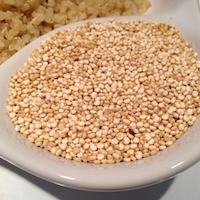This article was originally published on transforming-science.com.
Super Seeds
Quinoa is considered by most to be high in the ranks of “superfoods” as it is a complete source of protein, containing all nine essential amino acids. But there’s even more to quinoa than protein. The Chenopodium quinoa seed is a rich source of phytochemicals, plant-based compounds that boost human health in a different way than protein or other nutrients.
“Seeds capture the essence of a plant’s biochemistry profile, as they are tightly packed with nutrients, minerals, and phytochemicals critical to nurture and protect the developing seedling,” explained one of the study’s co-authors Slavko Komarnytsky, PhD, Associate Professor of Pharmacogenomics and Director of the Mobile Discovery program at PHHI. “In this study, we leached ecdysteroids naturally present in quinoa seeds and studied their effects on lifespan and energy metabolism.”
Komarnytsky’s research at PHHI is focused on studying how botanicals and natural products can restore metabolic and energy balance. The present study contributes to a growing body of knowledge surrounding quinoa and its beneficial properties, including a 2014 PHHI study of its phytochemicals and their ability to lower blood glucose in the context of diabetes.
A Seemingly Unexpected Research Model
The study used what may seem like an unexpected animal model, the nematode worm Caenorhabditis elegans or C. elegans. Nematodes are often used in studies related to aging because they are transparent, making cellular activity easier to view, and they have a short lifespan. Most importantly, they are a simple organism with specific types of metabolic genes that are similar to mammals. This leads scientists to believe that discoveries made while studying C. elegans are also likely to be applicable to humans.
Study Design
In the study, researchers measured the “healthspan” of C. elegans by monitoring:
- Lifespan
- Movement
- Advanced glycation end-product (AGE) pigments, molecules that accumulate during aging
- Reactive oxygen species (ROS), chemicals that cause cell damage and contribute to aging
To ensure that the effects observed in the study were due to phytochemicals and not another component of quinoa, red quinoa seeds were separated into a complex high-concentration phytochemical mixture and post-leached quinoa seeds.
“Leachate is the liquid that passes through the substance and absorbs soluble components from it,” Komarnytsky explained. “The use of leachate of quinoa seeds as a vehicle for extraction and concentration of its bioactive properties is an original idea of my collaborators at Rutgers University.”
20-hydroxyecdysone (20HE) is the most abundant phytochemical constituent of phytoecdysteroids, but quinoa also contains select amounts of other phytochemicals, including flavonoid glycosides, phenolic acids, betalains, and saponins.
Results
Their experiments showed – for the first time – that quinoa consumption slows C. elegans aging and improves the organism’s metabolic health by improving factors like lifespan and locomotory performance and decreasing negative factors such as AGE pigment, ROS, and lipid accumulation as a direct result of quinoa supplementation.
Based on these results, the study authors acknowledge that more research is needed but that the findings suggest that eating quinoa may “improve various aspects of health and wellness among aging populations.”
Learn more about the Plants for Human Health Institute.
Cook up some quinoa yourself:
Broccoli Quinoa Casserole
Quinoa Crust Pizza
Quinoa Omelet Bites
Quinoa Porridge


